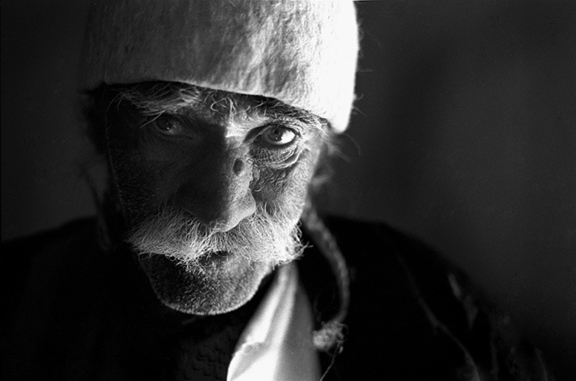Êzîdxan
Mittwoch, 25. Januar 2017 - 19:00 Uhr
Hinterland
curated by Bar?? Seyitvan
Opening: Talk with the Curator
Until two years ago few people except for a select group of specialists had ever heard of the Êzîdîs outside of Kurdistan. On August 3, 2014, the world was shocked by the tragedy that occurred in Iraq involving the Êzîdîs, when the ?Islamic State of Iraq and Syria? (ISIS) attacked them in Shingal (Sinj?r) and the surrounding area. The ISIS refers to Êzîdîs as ?infidels? (k?fir) and ?the worshippers of evil spirit?, whose only options are to convert to Islam or be killed. As Êzîdîs do not have a written Sacred Book, they are not considered by Muslims to be ahl al-kit?b (?people of the Book?). Under ISIS, Êzîdîs suffered mass killings, forced conversion to Islam, sexual slavery, and the abuse of their children as ISIS soldiers. According to some accounts from August 2014 onwards, around 6,000 Êzîdî women and girls (some as young as eight) were kidnapped by ISIS as ?spoils of war? and have been kept and sold as slaves by the ?Islamic State?. Around 4,500 Êzîdî women and girls still remain in captivity. Êzîdî boys and men aged 14 and over were mostly executed. Practically all Êzîdîs from the regions occupied by the IS, in total 350,000 Êzîdîs, fled the area and became refugees.
Being Kurds and non-Muslims, Êzîdîs have suffered greatly from both ethnic and religious persecution throughout history. Êzîdî oral history claims that they suffered 72 massacres (ferman), with the massacre of Êzîdîs in Shingal on 14th August 2007 and the genocide on 3rd August 2014 the 73rd and 74th ones. Partly due to the vast number of religious persecutions, the Êzîdîs became a closed community, which has led to there being many incorrect accounts on them. Their religion was often misunderstood, and besides the first association that comes to mind when one hears about the ?Êzîdîs?, i.e. victimhood and massacres, there are also stereotypes of them, such as their being ?the worshippers of evil spirit?, ?sun-worshippers?, or ?people having tails?, which are still surprisingly popular in the Middle East in the 21st century. Persecution is indeed an inseparable part of the Êzîdî history, but this exhibition also draws attention to the spiritual life that they managed to maintain through their history of resistance and survival.
The total Êzîdî population is probably over two percent of the Kurdish population. Êzîdîsm is based in the Kurdish-speaking areas of the Middle East and the Caucasus as well as in Europe. The majority of them still live in Iraq; the biggest Êzîdî community was living in Shingal. The main centre of the religion and its ceremonial rituals, Lalish, is located in the Sheikhan region, in the Autonomous Kurdistan Region of Iraq. In Shingal, however, a large number of Êzîdî holy places and pilgrim sites exist, some of which have already been destroyed by IS.
Kurmanji, the northern dialect of the Kurdish language, is the mother tongue of the Êzîdîs, wherever they live, as well as the language of practically all of their religious texts. Êzîdîsm, which is often called a ?sect?, a ?denomination? or a ?religion? in the literature, is a Kurdish non-proselytising monotheistic religion, called êzdiyatî or êzdîtî by its adherents.
In the 12th century Êzîdîsm underwent far-reaching reforms under Sheikh ?Ad? b. Mus?fir (1073/8?1162). Born in what is now Lebanon and dying in Lalish, he played an important role in the history of Êzîdîsm in the twelfth century. He introduced many Sufi elements, including a rich terminology, to Êzîdîsm, which many Êzîdîs see as an act that gave the Êzîdîs community a ?protective shield? in the 12th?13th centuries. Some Êzîdî tribes are cited in the historical chronicles as rulers with a sphere of influence stretching into what is now Syria and Turkey.
Êzîdîs believe in one God, who before the creation of this world created seven Divine Beings (often called ?angels?) and assigned all the world?s affairs to them, the leader of whom was appointed Tawûsî Melek (?Peacock Angel?). In Êzîdîsm, fire, water, air and the earth are sacred elements that are not to be polluted. During prayer Êzîdîs face towards the sun, for which they were often mistakenly called ?sun worshipers?. They do not believe in the existence of an evil spirit in opposition to God; according to Êzîdîsm, the Soul (ruh) is originally pure and sinless, but a human being has nefs, which is responsible for all human sins. Êzîdîs believe in rebirth of the soul, which plays an exceptional role in Êzîdî religiosity and is called the ?change of [one?s] shirt? (kirasgorîn). There is also a belief that some of the events from the time of Creation repeat themselves in cycles of history.
The Êzîdî religious tradition, both sacred texts and priestly learning, was transmitted orally in a non- or semi-literate milieu until recently. The Êzîdî religious textual tradition is very rich, with hymns (Qewls) occupying the main position, as they are believed to be revealed by God and contain the fundamental information about the Êzîdî ?philosophy?. Êzîdîsm, traditionally based primarily on orthopraxy, is undergoing profound changes as it finds itself in new circumstances resulting from migration, modernisation, globalisation, the role of the media and other external and internal influences. The IS attacks on Êzîdîs have not merely precipitated mass killings, slavery and forced conversion to Islam, as well as mass migrations and dislocations, but have consequently caused grave disruptions in Êzîdî community life. (Khanna Omarkhali, Assistant Professor Dr. / George August University of Göttingen)
A project in cooperation with Diyarbakir Sümerpark Amed Sanat Galerie, Diyarbakir, Turkey
the exhibition runs through March 4, 2017
